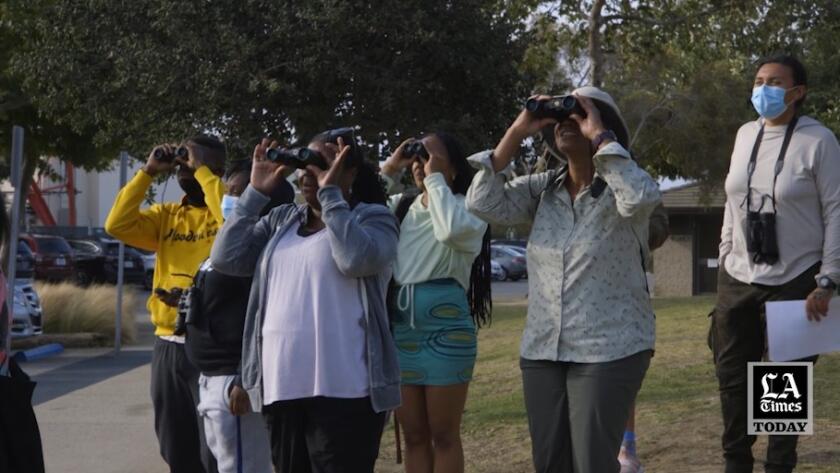Black birders are taking flight in L.A. Here’s how to join them
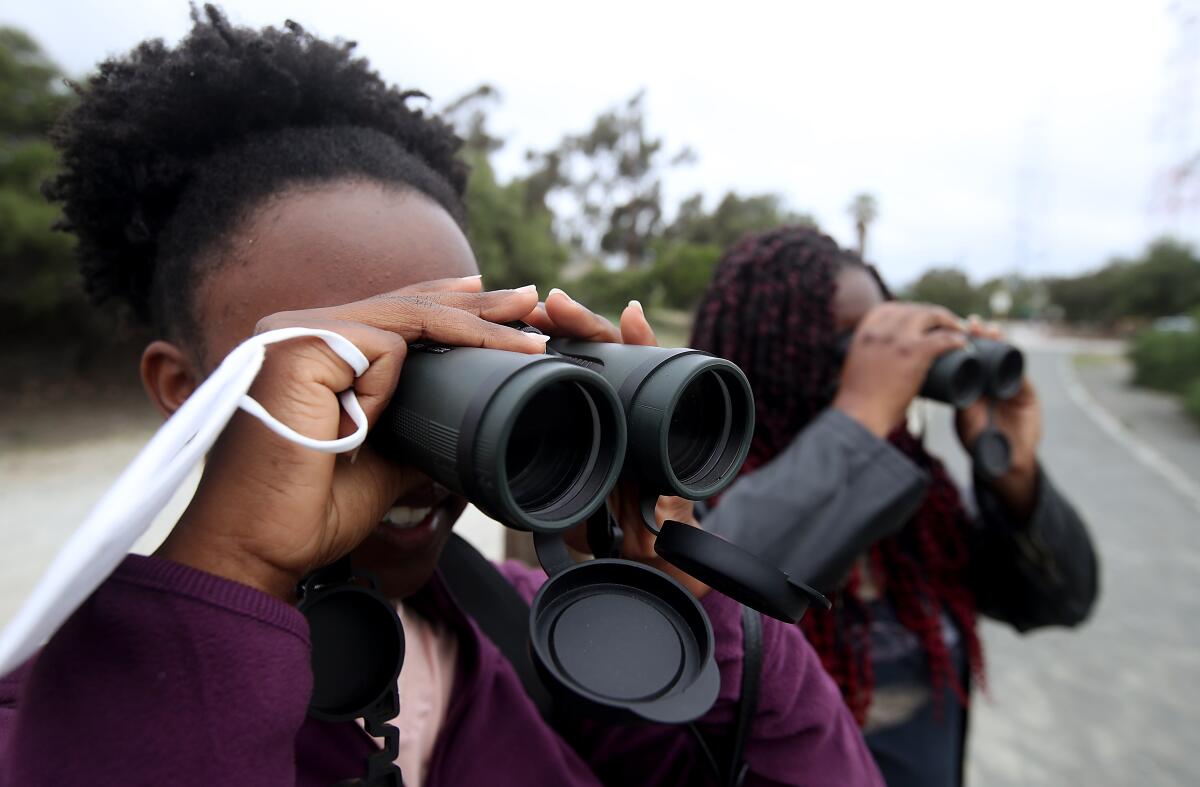
- Share via
Surrounded by wild sagebrush and bright yellow mustard, Jayden Samuels excitedly points out a hawk swooping downward in the sky. He’s bird watching in Kenneth Hahn State Recreation Area in Baldwin Hills, the downtown skyline in the distance, along with nine other Black Angelenos.
The 17-year-old is part of a small but passionate Black birding community in Los Angeles. It’s still rare to see a flock of Black people birding together in the city (many tend to fly solo), but as the pandemic has inspired new hobbies and an online campaign drew Black birders together, Samuels and other outdoor enthusiasts are hopeful that will change.
“People don’t associate us with the outdoors. I want to break that normality and make sure every Black person can go outdoors and feel safe,” says Samuels.
Just as hummingbirds, hawks, northern mockingbirds and blue scrub-jays flock to Kenneth Hahn State Recreation Area, it’s also become a popular gathering spot for Black birders, says Brian Young, an education and arts specialist with the Los Angeles Audubon Society, a nonprofit that focuses on education and conservation related to local birds.

For Black birders, learning about the city’s wildlife means so much more than peering through a pair of binoculars. It’s also about finding healing in the outdoors.
“It warms my heart when I am the person that gets to facilitate someone’s first experience with binoculars because that excitement that I hear people have, especially Black folks, being able to look through some scopes and be able to see a red-tailed hawk gliding in the sky, or even seeing a black phoebe catch these little flies. I can see their face — it just lightens up,” says Z Zetino, a community organizer who welcomes new L.A. birders, guiding them as they find a new appreciation for nature.
It’s easy to start birding in your backyard. All you need are binoculars and a bit of curiosity
Despite the joy that’s come from building up a Black birding community in real life, the online campaign that sparked the trend was born out of a painful moment. Soon after a white woman walking her dog called the police on Black birder Christian Cooper in New York City’s Central Park in May 2020 — a disturbing call that went viral in an online video — a cohort of activists developed Black Birders Week.
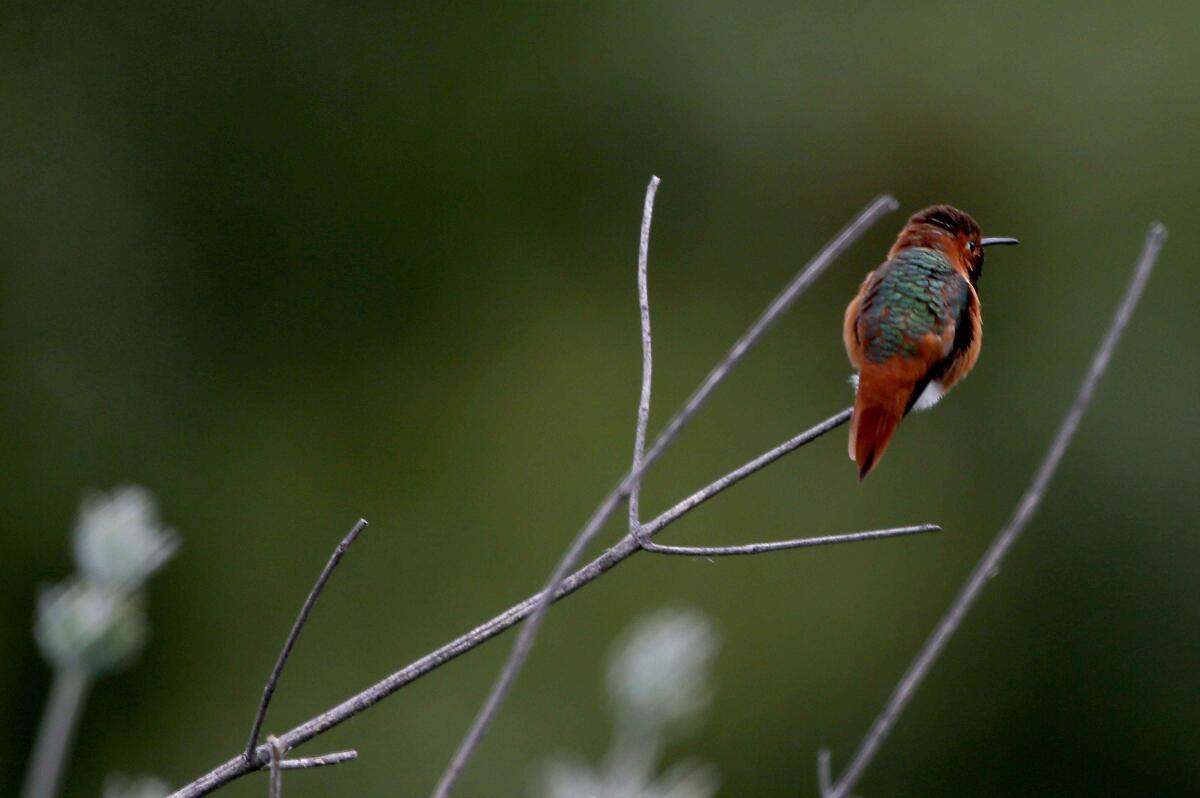
“The Christian Cooper incident was a turning point for Black people in the outdoors,” says Earyn McGee, 27, who recently moved to Los Angeles. She is an original Black Birders Week organizer and a scientist who studies reptiles and amphibians. “These are spaces where we are not expected to be. Any one of us could be a Christian Cooper.”
Black Birders Week, which this year runs May 29 through June 4, is a series of online events that increase the visibility of Black birders. After the first Black Birders Week, several Black nature enthusiasts developed even more campaigns around being Black in the outdoors and in the science community, like Black in National Parks Week and Black in Microbiology Week. In L.A., those online campaigns have led to IRL meetups, like the one Samuels attended on a cloudy Sunday in April.
Zetino believes that Black Birders Week isn’t just a hashtag — it’s a growing movement.
“Throughout history, we’ve seen this exclusion and we’ve seen how certain faces are not being highlighted. We see that in conservation, we see that in the outdoors, we see that with farming. It’s very white. We are out here,” says the 28-year-old.
Zetino became passionate about the outdoors at a young age when they would watch their grandmother tend to fruit trees and medicinal herbs. Zetino also took conservation courses at West Los Angeles College, one of which included a bird-watching field trip, sparking their interest in the hobby.
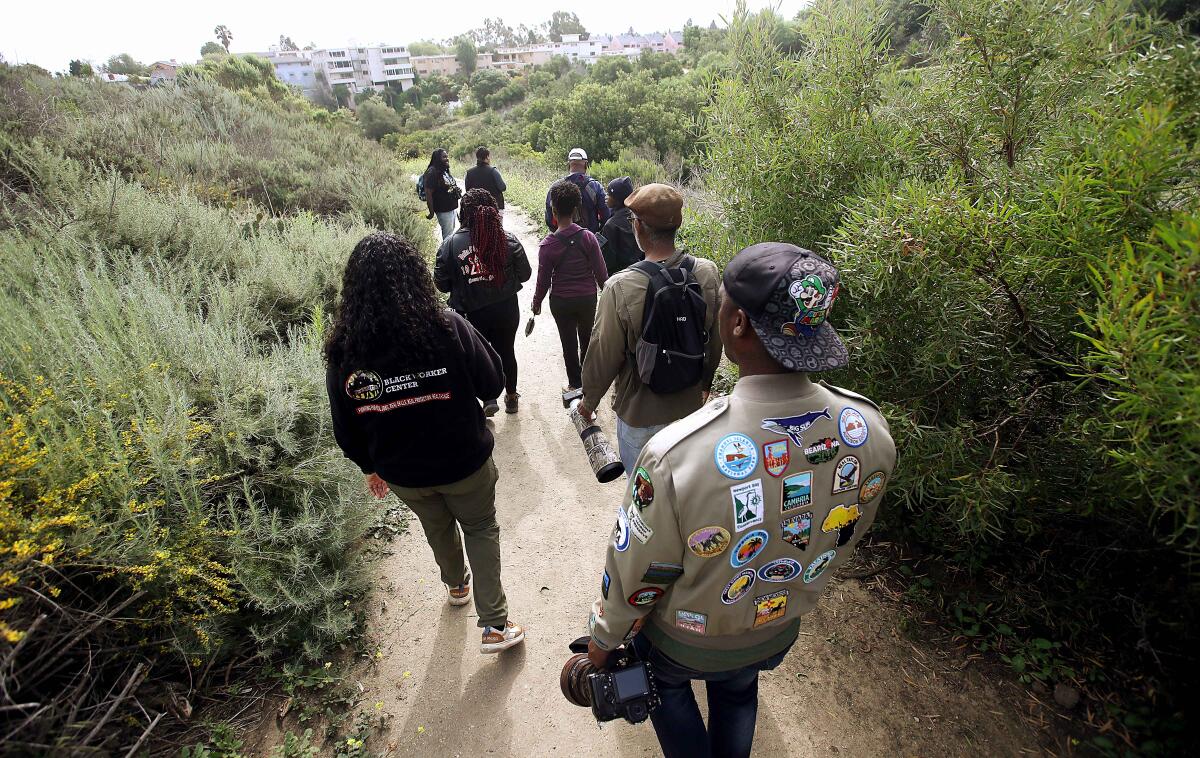
Samuels says he was first introduced to formal bird watching at 14 when he joined the North Hollywood High School Zoo Magnet program. He now can spend hours watching birds on the shores of Malibu Lagoon State Beach.
Birds “have the coveted power of flight, the most amazing colors you could ever imagine, and they are capable of interacting with humans on a deeper level than other animals,” says Samuels. “Birding makes me feel happy and almost free because going into nature is already fun, but when you have a genuine purpose while out in nature, it makes it that much better.”
- Share via
Watch L.A. Times Today at 7 p.m. on Spectrum News 1 on Channel 1 or live stream on the Spectrum News App. Palos Verdes Peninsula and Orange County viewers can watch on Cox Systems on channel 99.
Whether you’re looking for ocean views or desert landscapes or soaring mountain peaks, Los Angeles offers miles upon miles of strikingly different trails.
For those who are interested in bird-watching, there are plenty of ways to get started.
- Start with a local Instagram search for birding groups in your community. Use search terms like #birding and #birdwatching. Send a direct message to groups like Feminist Bird Club Los Angeles and Los Angeles Birders. Inquire about any upcoming events or predominantly Black bird-watching groups.
- In addition to Kenneth Hahn State Recreation Area, Ernest E. Debs Regional Park in Montecito Hills is a known spot for first-time bird watchers.
- The Los Angeles Audubon Society hosts in-depth tours about the diverse array of bird species that call the Greater Los Angeles area home. You can find the bird walks on the society’s website.
- If cost is a barrier, the Los Angeles Audubon Society will loan new birders binoculars during walks. But ”you don’t need binoculars,” says 29-year-old Young. “You can just go out anywhere and watch birds.” He recommends visiting a local beach or state park or taking a walk in your neighborhood. “People are generally unaware because we don’t stop to look up. Going on a walk in your neighborhood can be very eye-opening — especially for new birders.”
- You can also download the Audubon Bird Guide app and identify birds based on size, color, type, wing shape, tail shape, habitat, voice and activity. Apps like iNaturalist and Audubon Bird Guide help with identifying birds, while the greater scientific community uses eBird to discern migratory bird patterns.
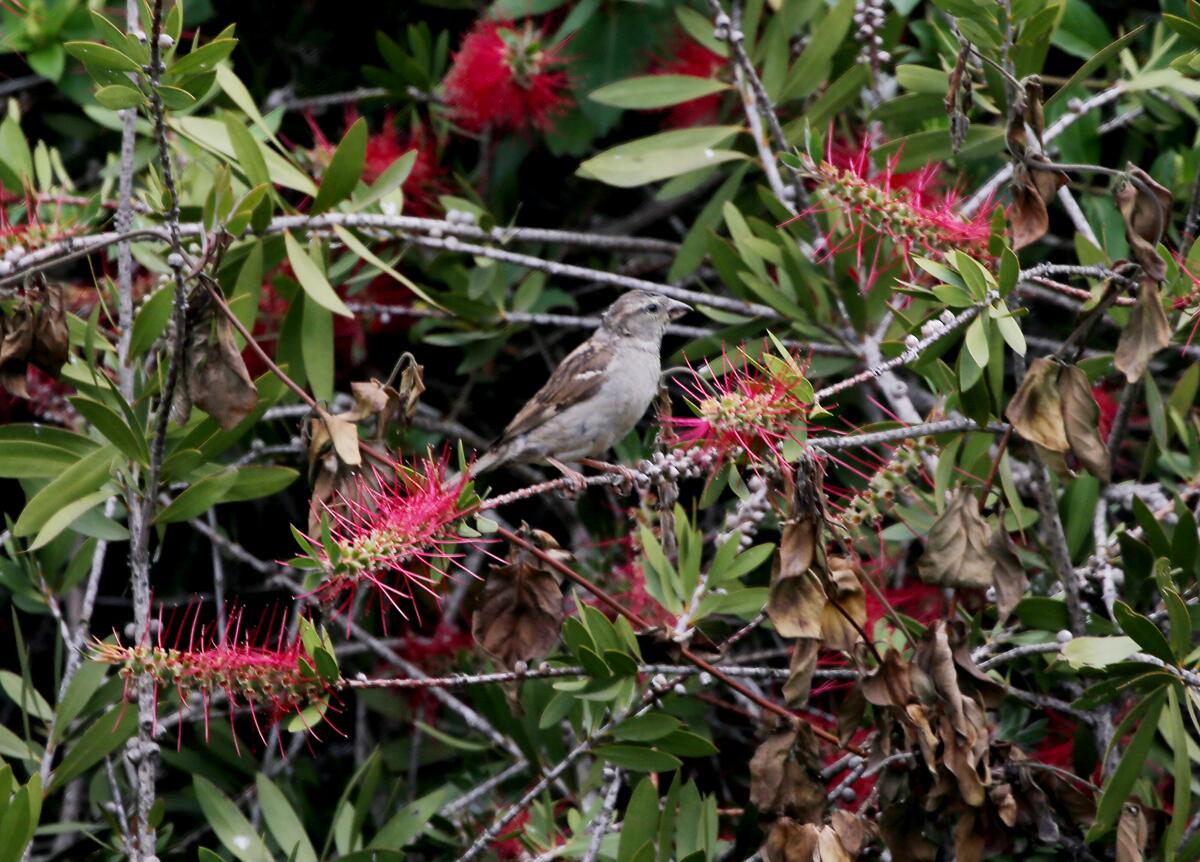
From Malibu Lagoon to the Sepulveda Basin Wildlife Reserve, Black birders are taking flight. They marvel at the gentle shorebirds of the Pacific coastline. They spot bright-bellied hummingbirds at local parks. They find beauty in birds from their own backyards.
Still, Black birders have to take their safety into serious consideration while outdoors, says McGee.
“My hopes are that we don’t have to continue having these kinds of conversations, that Black people can just get out and do what is enjoyable to them without being worried about being Black while doing it.”
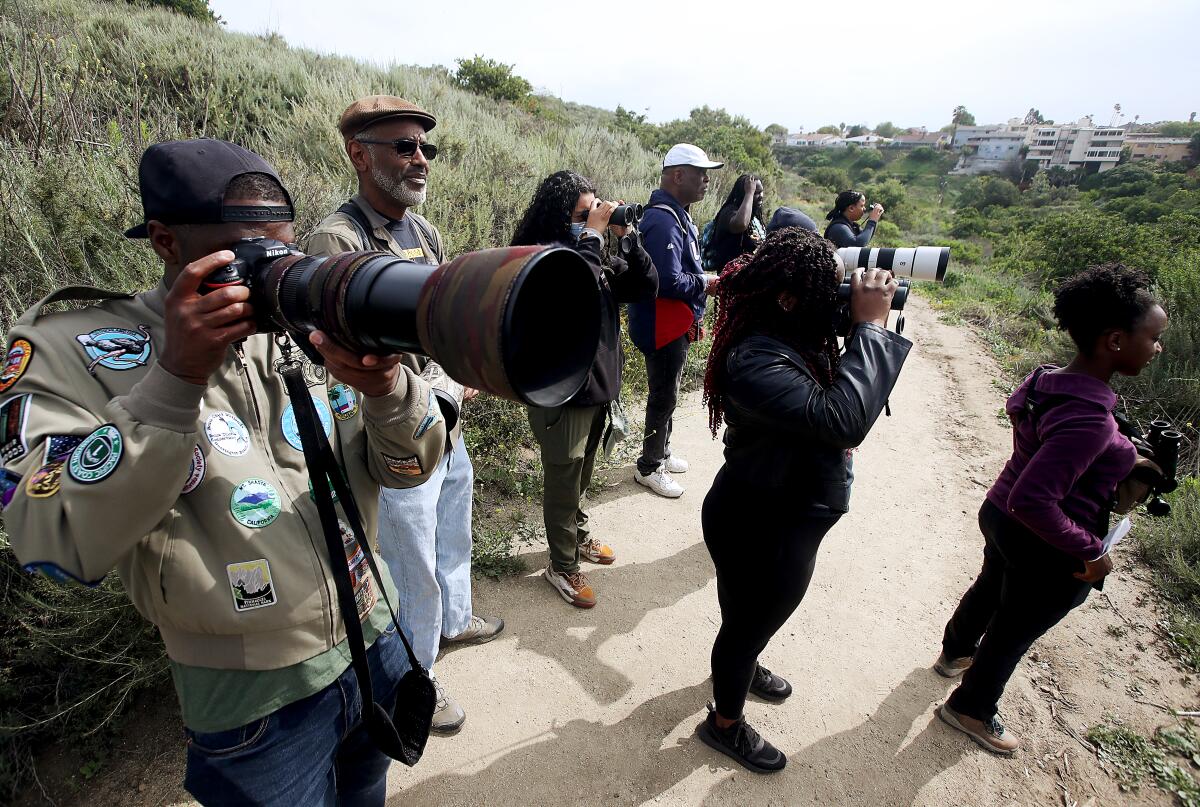
Maya Richard-Craven is a freelance writer in Pasadena.
More to Read
Sign up for The Wild
We’ll help you find the best places to hike, bike and run, as well as the perfect silent spots for meditation and yoga.
You may occasionally receive promotional content from the Los Angeles Times.

